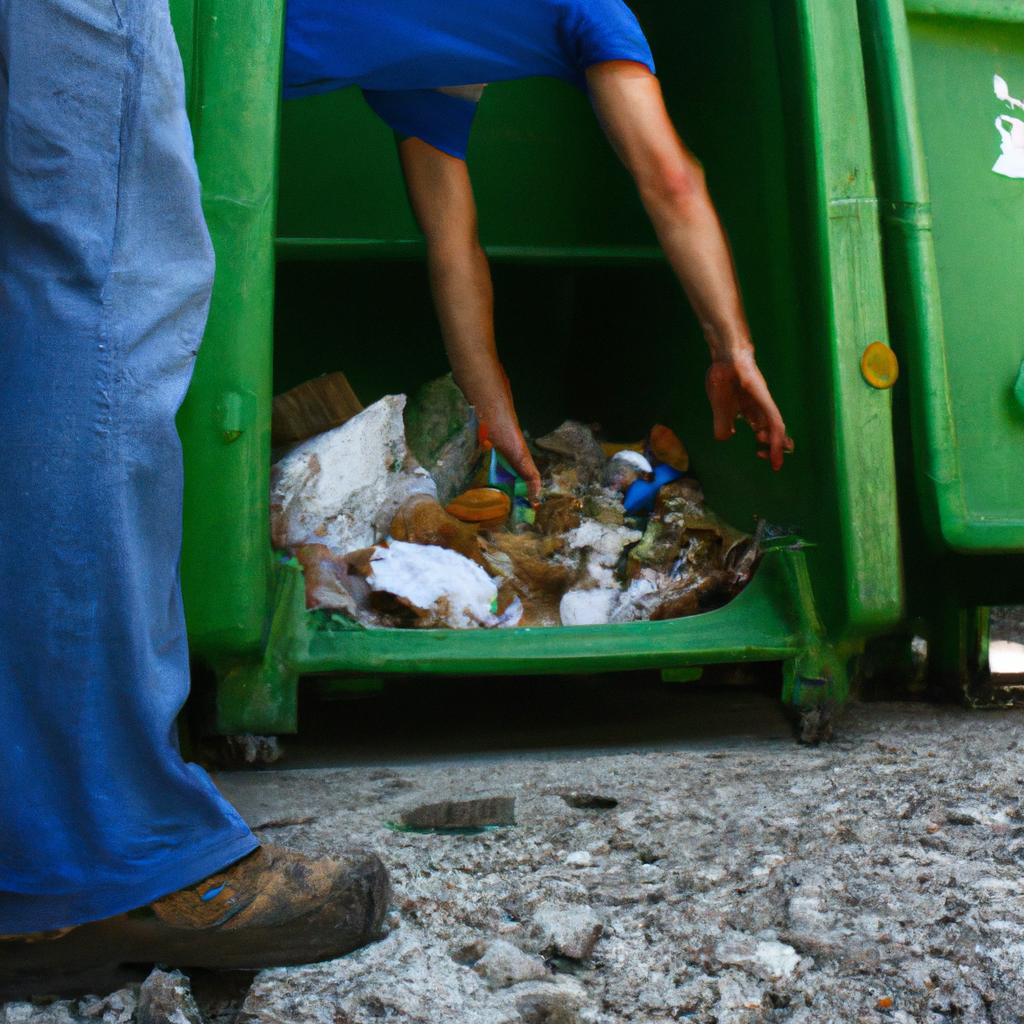Waste management is a critical issue in contemporary society, with far-reaching implications for the environment and human well-being. The improper handling and disposal of waste have led to significant environmental degradation, posing challenges to sustainable development. For instance, consider the hypothetical case of a densely populated urban area struggling with inadequate waste management infrastructure. In this scenario, unregulated dumping of waste can result in the contamination of soil, water sources, and air quality, consequently endangering public health.
To address these pressing concerns surrounding waste management, it is essential to gain insights into the complex interplay between societal factors and environmental consequences. This article aims to explore various dimensions of waste management issues from an environmental perspective. By examining the socio-economic factors influencing waste generation patterns and analyzing the impacts on ecosystems and natural resources, we can identify potential strategies for more effective waste management practices. Moreover, understanding the ethical aspects involved helps us recognize our collective responsibility towards minimizing waste generation and promoting sustainability.
In summary, this article delves into the multifaceted challenges posed by inefficient waste management practices in society today. Through a comprehensive analysis of environmental factors and societal influences, we aim to shed light on potential solutions that promote responsible waste management while safeguarding ecological integrity. Combining academic research with practical recommendations, Combining academic research with practical recommendations, this article seeks to contribute to the ongoing discourse on waste management by providing a holistic understanding of the issue and offering viable strategies for sustainable waste management. By highlighting the importance of proper waste handling, disposal, and recycling, we hope to inspire individuals, communities, and policymakers to take proactive measures towards minimizing waste generation and mitigating its environmental impacts. Ultimately, it is our collective responsibility to preserve and protect our environment for future generations.
Waste generation and its impact
One striking example of the growing waste problem can be seen in the case study of City X. Over the past decade, this urban area has experienced rapid population growth, leading to increased consumption patterns and subsequently higher rates of waste production. This illustrates how human activities contribute significantly to the issue of waste generation and highlights the need for effective strategies to mitigate its environmental impact.
Impacts on the environment:
The consequences of unchecked waste generation are far-reaching and pose significant challenges for our ecosystem. Firstly, excessive landfilling leads to soil contamination as hazardous substances from decomposing waste seep into the ground. This pollution poses a threat to both terrestrial and aquatic ecosystems, endangering biodiversity and compromising overall environmental health. Secondly, high levels of greenhouse gas emissions result from organic materials breaking down in landfills without proper management practices such as methane capture systems. These emissions further exacerbate global warming, contributing to climate change with dire consequences for humanity.
To fully grasp the gravity of the situation, consider the following points:
- Every year, millions of tons of plastic end up in oceans worldwide, causing harm to marine life through entanglement or ingestion.
- Landfill fires release toxic fumes into the air we breathe, posing severe health risks for nearby communities.
- The accumulation of electronic waste not only contaminates water sources but also results in resource depletion due to inefficient recycling practices.
- Improper disposal methods lead to visual blight that affects not only natural landscapes but also reduces property values within affected areas.
Table: Environmental Impacts
| Environmental Impact | Description |
|---|---|
| Soil Contamination | Hazardous substances leach into soil from decomposition processes at landfills |
| Greenhouse Gas Emissions | Organic waste breakdown produces methane gases contributing to climate change |
| Marine Pollution | Plastic waste entering oceans harms marine life through entanglement or ingestion |
| Resource Depletion | Inefficient recycling practices result in the loss of valuable resources |
Recognizing the urgency to address this pressing issue, a sustainable solution lies in embracing recycling as an effective waste management strategy. By diverting materials from landfills and transforming them into new products, recycling offers an opportunity to mitigate the environmental impacts discussed above.
Recycling as a sustainable solution
Waste generation and its impact on the environment have been a growing concern in society. Recycling has emerged as a sustainable solution to address these issues effectively.
To illustrate the importance of recycling, let us consider an example. Imagine a city that produces thousands of tons of plastic waste every year. This waste is mostly disposed of in landfills or incinerated, contributing to air and soil pollution. However, by implementing a comprehensive recycling program, this city could divert a significant portion of their plastic waste from landfills and instead transform it into new products like recycled plastic bottles or furniture. By doing so, they not only reduce the environmental impact but also create economic opportunities through the development of a circular economy.
Recycling offers several benefits that make it a viable solution for waste management:
- Conservation of natural resources: Through recycling, we can minimize our reliance on raw materials extracted from nature. This helps conserve valuable resources like timber, fossil fuels, water, and minerals.
- Energy savings: Recycling often requires less energy compared to manufacturing products from scratch. For instance, producing aluminum cans from recycled material consumes 95% less energy than producing them from virgin ore.
- Reduction in greenhouse gas emissions: Recycling helps mitigate climate change by reducing the need for energy-intensive processes associated with extracting and processing raw materials.
- Job creation: The recycling industry creates employment opportunities across various sectors such as collection services, sorting facilities, reprocessing plants, and research and development centers.
Table: Environmental Impact Comparison – Virgin Production vs. Recycling
| Virgin Production | Recycling | |
|---|---|---|
| Resource Consumption | High | Low |
| Energy Usage | High | Low |
| Greenhouse Gas Emissions | Significant | Reduced |
| Waste Generation | High | Reduced |
Overall, recycling plays a crucial role in waste management and offers numerous environmental and economic benefits. By diverting waste from landfills and utilizing it as a valuable resource, we can contribute to the preservation of our planet’s resources while minimizing negative impacts on ecosystems. In the subsequent section, we will explore another critical aspect of waste management: hazardous waste and its proper disposal.
Hazardous waste and its proper disposal
Transitioning seamlessly from the previous section on recycling, it is crucial to delve into the issue of hazardous waste and its proper disposal. To illustrate the significance of this topic, let us consider a hypothetical case study: imagine a chemical manufacturing plant that produces various substances for industrial use. Unfortunately, due to improper waste management practices, toxic chemicals are being discharged into nearby water bodies, posing serious health risks to both humans and wildlife.
Hazardous waste refers to any material or substance that possesses potential threats to human health or the environment. It includes but is not limited to chemicals, solvents, pesticides, radioactive materials, and medical waste. The mismanagement of these hazardous substances can lead to contamination of soil, air, and water sources with severe consequences for ecosystems and public health.
To address this pressing concern effectively, several key strategies must be implemented:
- Strict regulations: Governments need to establish stringent laws regarding the handling and disposal of hazardous waste. These regulations should cover all aspects from production to final disposal.
- Education and awareness campaigns: Raising public awareness about the dangers associated with improper disposal methods is essential. Educating individuals on how to identify hazardous materials correctly and promoting safe disposal practices can significantly reduce environmental harm.
- Encouraging alternative technologies: Promoting research and development in eco-friendly alternatives can help minimize the generation of hazardous waste altogether.
- Collaboration between industries and regulatory bodies: Establishing strong partnerships between industry stakeholders and regulatory agencies facilitates effective monitoring and enforcement of proper hazardous waste management practices.
Table – Examples of Common Types of Hazardous Waste:
| Type | Characteristics | Examples |
|---|---|---|
| Chemicals | Toxicity, flammability | Pesticides, cleaning agents |
| Radioactive Materials | Emit ionizing radiation | Uranium ore, nuclear fuel |
| Medical Waste | Infectious, biohazardous | Used needles, contaminated gloves |
| Electronic Waste | Toxic components (lead, mercury) | Old computers, smartphones |
In summary, the proper disposal of hazardous waste is essential to safeguard both human health and the environment. Strict regulations, education campaigns, research into alternative technologies, and collaboration between industries and regulatory bodies are all critical steps in achieving effective waste management practices. By taking action to address this issue responsibly, we can mitigate the adverse impacts of hazardous waste on our planet.
Moving forward, it is vital to consider the role of government and regulations in ensuring responsible waste management practices.
Role of government and regulations
Having explored hazardous waste and its proper disposal, it is crucial to examine the role of government and regulations in managing waste effectively. One notable case study that highlights this involvement is the implementation of waste management policies by the government of Country X.
Government Intervention in Waste Management
In Country X, the government has taken significant steps to address waste management issues. For instance, they have established strict regulations on waste disposal practices to protect public health and preserve the environment. These regulations include guidelines for proper segregation, collection, transportation, treatment, and disposal methods for different types of waste materials.
The Importance of Government Regulations
Government regulations play a vital role in ensuring compliance with environmentally responsible waste management practices. By implementing stringent standards and monitoring mechanisms, governments can ensure that both individuals and businesses adhere to ethical waste disposal procedures. This helps prevent illegal dumping or improper handling of hazardous substances that could potentially harm ecosystems and human well-being.
An Emotional Perspective on Government Intervention:
- Increased transparency through public reporting on waste management initiatives.
- Enhanced enforcement measures against non-compliant organizations.
- Collaborative efforts between government agencies and private stakeholders.
- Promoting awareness among citizens about their responsibility towards sustainable waste management.
Table (3 columns x 4 rows):
| Advantages | Disadvantages | |
|---|---|---|
| Pros | – Reduction in environmental pollution | – Potential financial burden on small businesses |
| – Protection of public health | – Limited resources for effective enforcement | |
| Cons | – Higher level of accountability | – Resistance from industry players |
| – Improved overall resource efficiency | – Complex regulatory frameworks |
Moving Forward: Waste-to-Energy Technologies
As we delve into the next section about “Waste-to-energy technologies,” it becomes evident that government intervention and regulations are crucial for sustainable waste management. By enforcing strict guidelines, governments can pave the way for innovative solutions to reduce waste generation and promote a circular economy that maximizes resource utilization. Through effective governance, we can strive towards a future where waste is seen as a valuable resource rather than an environmental burden.
Waste-to-energy technologies
Building on the role of government and regulations in waste management, another important aspect to consider is the implementation of waste-to-energy technologies. These innovative solutions offer promising alternatives for efficient waste disposal and energy generation.
Waste-to-energy (WTE) technologies have gained significant attention in recent years due to their potential environmental and economic benefits. One example that showcases the effectiveness of these technologies is the city of Stockholm, Sweden. In an effort to reduce landfill usage and promote sustainable practices, Stockholm implemented a WTE plant that converts municipal solid waste into electricity and heat. This case study highlights how waste can be transformed into valuable resources through technological advancements.
To further understand the significance of waste-to-energy technologies, let us explore some key points:
- Environmental impact reduction: By converting waste into energy, WTE technologies help minimize methane emissions from landfills, which are potent greenhouse gases contributing to climate change.
- Resource conservation: WTE plants enable recovery of materials like metals and plastics during the incineration process, reducing extraction pressure on natural resources.
- Energy generation: Waste serves as a renewable source for producing electricity or thermal energy through combustion processes.
- Land use optimization: Implementing WTE facilities reduces reliance on traditional landfill sites, allowing for repurposing or preservation of land areas.
Table showcasing comparison between landfilling and waste-to-energy technology:
| Landfilling | Waste-to-Energy Technology | |
|---|---|---|
| Greenhouse gas emissions | High | Reduced |
| Resource recovery | Limited | Enhanced |
| Energy production | None | Significant |
| Land requirements | Extensive | Minimal |
By embracing waste-to-energy technologies, societies can move towards more sustainable approaches to managing their waste streams. However, it is essential to ensure proper monitoring and regulation throughout the implementation process to address any potential environmental or health concerns. These technologies, when integrated effectively within waste management systems, have the potential to revolutionize how we handle and utilize our waste resources.
Recognizing the importance of public awareness and education in promoting sustainable waste management practices is crucial for building a more environmentally conscious society.
Importance of public awareness and education
Building upon the discussion of waste-to-energy technologies, it is imperative to explore the importance of public awareness and education in addressing waste management challenges. By increasing knowledge and understanding, individuals can actively contribute to sustainable waste management practices and foster positive environmental change.
Section 2: Importance of Public Awareness and Education
To illustrate the significance of public awareness, consider a hypothetical case study involving two communities with contrasting levels of waste management education. Community A has implemented comprehensive educational programs that emphasize recycling habits, composting techniques, and responsible consumption patterns. As a result, they have achieved an impressive reduction in landfill-bound waste by 50% over five years. In contrast, Community B lacks such initiatives and struggles with excessive waste accumulation, leading to increased pollution levels and strained resources.
Engendering public awareness on waste management through effective education campaigns brings several benefits:
- Promotes behavioral changes: Raising awareness about the impact of improper waste disposal encourages individuals to adopt more sustainable practices.
- Reduces contamination rates: Educating citizens about proper sorting methods helps minimize contamination in recycling streams, facilitating efficient material recovery processes.
- Fosters community engagement: Collaborative efforts initiated through educational programs strengthen social cohesion within communities while creating a shared commitment towards waste reduction goals.
- Encourages innovation and research: Increased public interest in waste management stimulates investments in research for developing new technologies and methodologies.
Additionally, utilizing visual tools like tables can evoke an emotional response among audiences when presenting data concerning environmental degradation caused by poor waste management practices. Consider the following table showcasing alarming statistics related to global plastic pollution:
| Plastic Production (in million tons) | Plastic Waste Generated (in million tons) | Percentage Recycled | |
|---|---|---|---|
| Year 1950 | 1.5 | 0.5 | – |
| Year 2019 | 368 | 215 | 9% |
| Estimated by 2050 | 12000 | >10000 | <10% |
These figures highlight the urgent need for widespread education and awareness to combat plastic pollution effectively.
In conclusion, the importance of public awareness and education in waste management cannot be overstated. By increasing knowledge, fostering behavioral changes, and encouraging innovation, individuals can actively contribute towards sustainable waste management practices. Efforts should focus on implementing comprehensive educational programs that engage communities and empower them with the information needed to make informed choices regarding waste disposal methods. Only through collective action can we mitigate environmental degradation caused by improper waste management practices.





